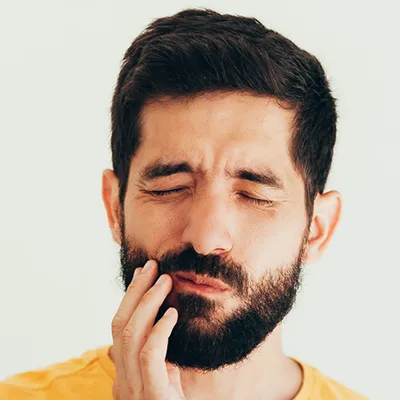Dental emergencies can hit you at any time leading to pain, discomfort, and even potential long-term damage if not addressed promptly. Knowing how to respond to the situation can create a huge difference, whether it’s a sudden toothache or an accidental injury.
Let’s explore 8 common dental emergencies you might encounter suddenly. We will also highlight the symptoms that indicate you need to visit your emergency dentist.

What is a Dental Emergency?
A dental emergency refers to any oral health issue requiring immediate attention to alleviate severe pain, stop bleeding, or save a tooth. Such situations often involve sudden, unexpected problems that can significantly impact a person’s daily life and overall health.
Dental emergencies can result from various causes, including accidents, sports injuries, untreated infections, or biting on hard objects.
Why You Should Know How to Respond to Dental Emergencies
- Providing pain relief
- Preventing complications
- Saving your teeth
- Stopping bleeding
- Reducing infection risk
- Minimizing Damage
8 Common Dental Emergencies
1: Toothache
Gum Disease:
- Intermittent or continuous sharp, throbbing pain
- Increased sensitivity to hot and cold foods
- Swelling or redness around the gums
- Bad taste or odor in your mouth
2: Chipped or Broken Tooth
Common Symptoms
- A visible presence of a chip or crack in the tooth.
- Sharp or jagged edges that can be felt with the tongue
- Intermittent pain and increased sensitivity
- Swelling and tenderness
- Difficulty chewing certain foods
- Gum bleeding
- Tooth bleeding
- Change in tooth appearance, such as discoloration
3: Knocked-Out Tooth
Common Symptoms
- Severe pain
- Persistent and profuse bleeding
- Visibly empty socket
- Swelling and bruising
- Numbness or tingling
- Sensitivity accompanied by discomfort
- Difficulty in speaking and eating
4: Lost Filling or Crown
Common Symptoms
- Increased sensitivity to hot and cold foods, sweet or sour foods, and cold air
- Pain and discomfort
- Visible changes in the tooth
- Food getting stuck in the exposed cavity
- Gum irritation around the tooth
5: Abscess
Common Symptoms
- Severe toothache that may radiate to the jaw, ear, or neck.
- Swelling in the gums, face, or lymph nodes
- Accumulated pus at the site of the abscess
- Sensitivity to pressure around the tooth
- Fever (in severe cases)
- Foul taste in the mouth due to the pus drainage
- Difficulty in swallowing or breathing
6: Broken Orthodontics
Common Symptoms
- Discomfort or pain due to broken appliance rubbing cheeks, tongue, or gums again
- Sharp edges that cause sores or cuts inside the mouth
- Loose brackets or bands
- Change in wire positions
- Difficulty in chewing
- Change in tooth movement
- Visible damage
7: Soft Tissue Injuries (Lips, Tongue, Cheeks)
Common Symptoms
- Bleeding, severe or little, depending on the extent of the injury
- Pain or discomfort, particularly while speaking or eating
- Swelling around the injured area
- Redness around the affected area
- Difficulty in eating or drinking
- Formation of mouth ulcers
8: Jaw or Mouth Trauma
Common Symptoms
- Mild discomfort to severe pain in your jaw or mouth
- Swelling in the jaw or mouth
- Bruising over the skin that overlays the jaw or inside the mouth
- Difficulty in opening or closing your mouth
- Jaw stiffness
- Misaligned jaw
- Tooth damage, such as fractures, chips or dislodgment
- Difficulty in speaking
Why You Should Immediately Seek Professional Help
- Getting Immediate Relief from Pain: Emergency dentists can alleviate your pain immediately, helping you feel more comfortable until further treatment.
- Preventing Further Damage: Ignoring a dental emergency can lead to further damage or complications. Seeking prompt dental care can prevent such issues from worsening.
- Preserving Teeth: Immediate dental intervention can increase the chances of saving the tooth.
- Treatment of Infections: Emergency dentists can provide antibiotics or perform procedures such as root canals to effectively address tooth infections and prevent them from spreading to other parts of the body.
- Resolving Orthodontic Issues: Broken braces or wires can cause discomfort and may interfere with orthodontic treatment. Emergency dentists can address these issues promptly to prevent delays in your orthodontic progress.
- Expert Guidance & Advice: Emergency dentists provide expert guidance and advice, helping you navigate the situation and make informed decisions about your oral health.
Conclusion
Understanding the signs and symptoms can equip you to respond correctly to the 8 common dental emergencies. From severe toothaches to knocked-out teeth, each dental emergency presents unique challenges that require prompt attention and care from a qualified dentist.
By seeking professional help, you can effectively manage dental emergencies, alleviate pain, prevent further damage, and preserve your teeth.
Dental Emergency? Experience Peace of Mind at Chevy Chase Dental Care
Dental emergencies can cause quite a panic and render you helpless in such situations. Chevy Chase Dental Care understands that and is here to offer prompt and compassionate emergency dentistry services that can relieve pain and restore your smile.
Contact us now at (301) 302-7761 or (301) 652-5881 to schedule your emergency dental appointment.
FAQs
What should I do if I have a severe toothache in the middle of the night?
- Rinse your mouth with warm water.
- Gently floss around the affected tooth to remove any trapped debris.
- Take over-the-counter pain medication as directed.
- Contact an emergency dentist for guidance and schedule an appointment as soon as possible.
